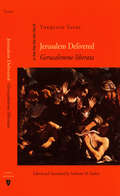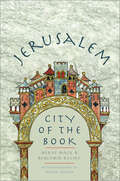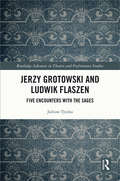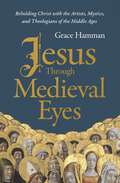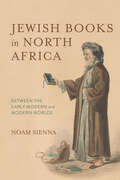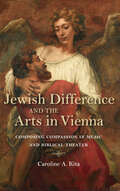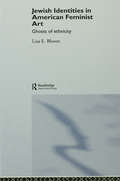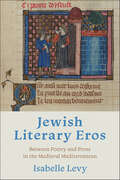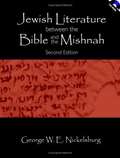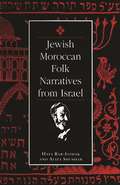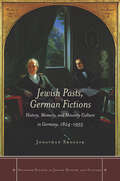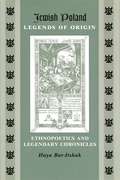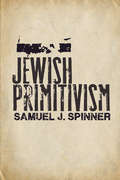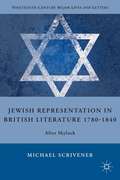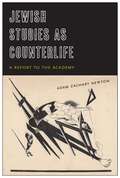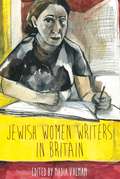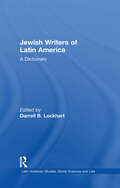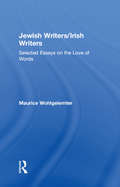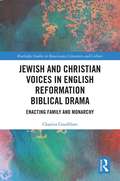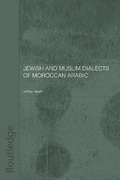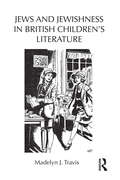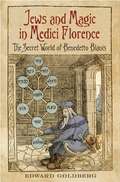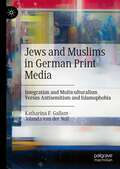- Table View
- List View
Jerusalem Delivered (Gerusalemme liberata): Gerusalemme Liberata
by Torquato TassoLate in the eleventh century the First Crusade culminated in the conquest of Jerusalem by Christian armies. Five centuries later, when Torquato Tasso began to search for a subject worthy of an epic, Jerusalem was governed by a sultan, Europe was in the crisis of religious division, and the Crusades were a nostalgic memory. Tasso turned to the First Crusade both as a subject that would test his poetic ambition and as a reflection on the quandaries of his own time. He sought to create a masterpiece that would deserve comparison with the great epics of the past.Gerusalemme liberata became one of the most widely read and cherished books of the Renaissance. First published in 1581, it was translated into English by Edward Fairfax in 1600. That translation has been the standard, even though Fairfax was only a good, not a great, poet. Fairfax tried to fit Tasso's verse into Spenserian stanzas, adding to and subtracting from the original and often changing Tasso's meaning.Anthony Esolen's new translation captures the delight of Tasso's descriptions, the different voices of its cast of characters, the shadings between glory and tragedy—and it does all this in an English as powerful and clear as Tasso's Italian. Tasso's masterpiece finally emerges as an English masterpiece.
Jerusalem: City of the Book
by Benjamin Balint Merav MackA captivating journey through the hidden libraries of Jerusalem, where some of the world’s most enduring ideas were put into words In this enthralling book, Merav Mack and Benjamin Balint explore Jerusalem’s libraries to tell the story of this city as a place where some of the world’s most enduring ideas were put into words. The writers of Jerusalem, although renowned the world over, are not usually thought of as a distinct school; their stories as Jerusalemites have never before been woven into a single narrative. Nor have the stories of the custodians, past and present, who safeguard Jerusalem’s literary legacies. By showing how Jerusalem has been imagined by its writers and shelved by its librarians, Mack and Balint tell the untold history of how the peoples of the book have populated the city with texts. In their hands, Jerusalem itself—perched between East and West, antiquity and modernity, violence and piety—comes alive as a kind of labyrinthine library.
Jerzy Grotowski and Ludwik Flaszen: Five Encounters with the Sages (Routledge Advances in Theatre & Performance Studies)
by Juliusz TyszkaThe book contains three accounts of five public speeches and conversations with the public of two outstanding figures of theatre and performance, Jerzy Grotowski and Ludwik Flaszen, from 1993 to 1997. Their speeches concern their output and their current research. The content of Ludwik Flaszen's speech is very closely related to the output of Jerzy Grotowski. The accounts are written on the base of the author's detailed notes. The main subject of these narratives is their author, who quotes the speaking characters in the third person. In this way, all texts acquire a subjective character, akin to an essay, while remaining faithful to the overall message and content of the speeches and conversations cited in them. Juliusz Tyszka also uses this form of narration to describe the interpersonal context of Flaszen’s and Grotowski’s talks, including the content and tone of the questions asked, the reactions of listeners, etc. There is also room for short, concise characteristics of these two outstanding people and their interlocutors (who are themselves sometimes also notorious). This book will be of great interest to scholars and students of theatre and performance studies and professionals in experimental theatre and performance.
Jesus through Medieval Eyes: Beholding Christ with the Artists, Mystics, and Theologians of the Middle Ages
by Grace HammanJesus through Medieval Eyes will take you on an exploration of medieval representations of Jesus in theology and literature.Who is Jesus? What is he like? And who am I, encountering Jesus? These questions were just as important to Christians in the Middle Ages as they are today.And yet—as C.S. Lewis noted—the modern church tends to forget that people of different cultures and times also thought carefully about who Jesus was; and sometimes their ideas and emphases were different.Medievalist scholar Grace Hamman believes that we can deepen our understanding and adoration of Christ by looking to the Christians of the Middle Ages. Medieval Europeans were also suffering through pandemics, dealing with political and ecclesial corruption and instability, and reckoning with gender, money, and power. But their concerns and imaginations are unlike ours. Their ideas, narratives, and art about Jesus open up paradoxically fresh and ancient ways to approach and adore Christ—and to reveal where our own cultural ideals about the Messiah fall short.Medieval representations of Jesus span from the familiar—like Jesus as the Judge at the End of Days, or Jesus as the Lover of the Song of Songs—to the more unusual, like Jesus as Our Mother. Through the words of medieval people like Julian of Norwich, St. Bernard of Clairvaux, Margery Kempe, and St. Thomas Aquinas, we meet these faces of Jesus and find renewed ways to love the Savior, in the words of St. Augustine, that "beauty so ancient and so new."
Jewish Books in North Africa: Between the Early Modern and Modern Worlds (Sephardi and Mizrahi Studies)
by Noam SiennaJewish Books in North Africa delves into the multifaceted significance of books among North African Jews. From the late Middle Ages to the 19th century, this exploration encompasses the history, manufacture, distribution, and readership of Jewish books. These texts were not mere vessels of knowledge; they were integral to a vibrant cultural tapestry that stretched across North Africa, the Middle East, and Europe.Author Noam Sienna unveils a vast Sephardic world created by these books. This literary network transcended geographical boundaries, connecting Jewish communities from Fez and Tunis to Salonica, Jerusalem, and Livorno.By examining cultural centers and tracing the journey of these texts, Sienna provides depth to our understanding of a remarkably global and worldly book culture, and its evolving role in the growth of Jewish modernity.While the content of Jewish books has long fascinated scholars, Jewish Books in North Africa shifts our focus to the physical context. These books were not isolated artifacts; they were embedded in cultural networks during a period of religious, political, and cultural transformation. Sienna's work sheds light on the intricate interplay between books and the dynamic world in which they existed.
Jewish Difference and the Arts in Vienna: Composing Compassion in Music and Biblical Theater (German Jewish Cultures)
by Caroline A. KitaThis study “brings to life a circle of writers and composers, with analyses of their major, minor . . . and forgotten works of Jewish music theater” (Abigail Gillman, author of Viennese Jewish Modernism).During the mid-19th century, the works of Arthur Schopenhauer and Richard Wagner sparked an impulse toward German cultural renewal and social change that drew on religious myth, metaphysics, and spiritualism. The only problem was that their works were deeply antisemitic and entangled with claims that Jews were incapable of creating compassionate art. By looking at the works of Jewish composers and writers who contributed to a lively and robust biblical theatre in fin de siècle Vienna, Caroline A. Kita shows how they reimagined myths of the Old Testament to offer new aesthetic and ethical views of compassion.These Jewish artists, including Gustav Mahler, Siegfried Lipiner, Richard Beer-Hofmann, Stefan Zweig, and Arnold Schoenberg, reimagined biblical stories through the lens of the modern Jewish subject to plead for justice and compassion toward the Jewish community. By tracing responses to antisemitic discourses of compassion, Kita reflects on the explicitly and increasingly troubled political and social dynamics at the end of the Habsburg Empire.
Jewish Identities in American Feminist Art: Ghosts of Ethnicity
by Lisa E. BloomFeaturing sixty-seven illustrations, and providing an important reckoning and visualization of the previously hidden Jewish 'ghosts' within US art, Jewish Identities in American Feminist Art addresses the veiled role of Jewishness in the understanding of feminist art in the United States. From New York city to Southern California, Lisa E. Bloom situates the art practices of Jewish feminist artists from the 1970s to the present in relation to wider cultural and historical issues. Key themes are examined in depth through the work of contemporary Jewish artists including: Eleanor Antin Judy Chicago Deborah Kass Rhonda Lieberman Martha Rosler and many others. Crucial in any study of art, visual studies, women's studies and cultural studies, this is a new and lively exploration into a vital component of US art.
Jewish Languages from A to Z
by Lily Kahn Aaron D. RubinJewish Languages from A to Z provides an engaging and enjoyable overview of the rich variety of languages spoken and written by Jews over the past three thousand years. The book covers more than 50 different languages and language varieties. These include not only well-known Jewish languages like Hebrew, Yiddish, and Ladino, but also more exotic languages like Chinese, Esperanto, Malayalam, and Zulu, all of which have a fascinating Jewish story to be told. Each chapter presents the special features of the language variety in question, a discussion of the history of the associated Jewish community, and some examples of literature and other texts produced in it. The book thus takes readers on a stimulating voyage around the Jewish world, from ancient Babylonia to 21st-century New York, via such diverse locations as Tajikistan, South Africa, and the Caribbean. The chapters are accompanied by numerous full-colour photographs of the literary treasures produced by Jewish language-speaking communities, from ancient stone inscriptions to medieval illuminated manuscripts to contemporary novels and newspapers. This comprehensive survey of Jewish languages is designed to be accessible to all readers with an interest in languages or history, regardless of their background—no prior knowledge of linguistics or Jewish history is assumed.
Jewish Literary Eros: Between Poetry and Prose in the Medieval Mediterranean (Sephardi and Mizrahi Studies)
by Isabelle LevyIn Jewish Literary Eros, Isabelle Levy explores the originality and complexity of medieval Jewish writings. Examining medieval prosimetra (texts composed of alternating prose and verse), Levy demonstrates that secular love is the common theme across Arabic, Hebrew, French, and Italian texts. At the crossroads of these spheres of intellectual activity, Jews of the medieval Mediterranean composed texts that combined dominant cultures' literary stylings with biblical Hebrew and other elements from Jewish cultures. Levy explores Jewish authors' treatments of love in prosimetra and finds them creative, complex, and innovative.Jewish Literary Eros compares the mixed-form compositions by Jewish authors of the medieval Mediterranean with their Arabic and European counterparts to find the particular moments of innovation among textual practices by Jewish authors. When viewed in the comparative context of the medieval Mediterranean, the evolving relationship between the mixed form and the theme of love in secular Jewish compositions refines our understanding of the ways in which the Jewish literature of the period negotiates the hermeneutic and theological underpinnings of Islamicate and Christian literary traditions.
Jewish Literature Between the Bible and the Mishnah: A Historical and Literary Introduction
by George W. E. NickelsburgIn this fully revised and expanded edition, George W. E Nickelsburg introduces the reader to the broad range of Jewish literature that is not part of either the Bible or the standard rabbinic works. This includes especially the Apocrypha (such as 1 Maccabees), the Pseudepigrapha (such as 1 Enoch), the Dead Sea Scrolls, the works of Josephus, and the works of Philo. This new edition also has an enormously helpful CD-ROM, including biblical citation hyperlinks to the NRSV, web links to primary documents, chapter summaries, discussion questions, and about 100 images of related sites and artifacts.
Jewish Moroccan Folk Narratives from Israel (Raphael Patai Series in Jewish Folklore and Anthropology)
by Haya Bar-Itzhak Aliza ShenharJewish Moroccan Folk Narratives focuses on two central elements: textual research to examine the aesthetic qualities of the narrative, their division into genres, the various versions and their parallels, and acculturation in Israel, as well as contextual research to examine the performance art of the narrator and the role of the narrative as a communicative process in the narrating society. The collection includes twenty-one narratives by twelve storytellers; an account of the narrators' lives and a commentary have been applied to each. In contrast to most anthologies of Jewish folktales, the texts in this book were recorded in the natural context of narration and in the language of origin (Judaeo-Arabic), meeting the most vigorous standards of current folklore scholarship.
Jewish Pasts, German Fictions: History, Memory, and Minority Culture in Germany, 1824-1955
by Jonathan SkolnikJewish Pasts, German Fictions is the first comprehensive study of how German-Jewish writers used images from the Spanish-Jewish past to define their place in German culture and society. Jonathan Skolnik argues that Jewish historical fiction was a form of cultural memory that functioned as a parallel to the modern, demythologizing project of secular Jewish history writing. What did it imply for a minority to imagine its history in the majority language? Skolnik makes the case that the answer lies in the creation of a German-Jewish minority culture in which historical fiction played a central role. After Hitler's rise to power in 1933, Jewish writers and artists, both in Nazi Germany and in exile, employed images from the Sephardic past to grapple with the nature of fascism, the predicament of exile, and the destruction of European Jewry in the Holocaust. The book goes on to show that this past not only helped Jews to make sense of the nonsense, but served also as a window into the hopes for integration and fears about assimilation that preoccupied German-Jewish writers throughout most of the nineteenth century. Ultimately, Skolnik positions the Jewish embrace of German culture not as an act of assimilation but rather a reinvention of Jewish identity and historical memory.
Jewish Poland—Legends of Origin: Ethnopoetics and Legendary Chronicles (Raphael Patai Series in Jewish Folklore and Anthropology)
by Haya Bar-ItzhakThe first appearance of Jews in Poland and their adventures during their early years of settlement in the country are concealed in undocumented shadows of history. What survived are legends of origin that early chroniclers, historians, writers, and folklore scholars transcribed, thus contributing to their preservation. According to the legendary chronicles Jews resided in Poland for a millennium and developed a vibrant community. <P><P> Haya Bar-Itzhak examines the legends of origin of the Jews of Poland and discloses how the community creates its own chronicle, how it structures and consolidates its identity through stories about its founding, and how this identity varies from age to age. Bar-Itzhak also examines what happened to these legends after the extermination of Polish Jewry during the Holocaust, when the human space they describe no longer exists except in memory. For the Polish Jews after the Holocaust, the legends of origin undergo a fascinating transformation into legends of destruction. <P><P> Jewish Poland-Legends of Origin brings to light the more obscure legends of origin as well as those already well known. This book will be of interest to scholars in folklore studies as well as to scholars of Judaic history and culture.
Jewish Primitivism (Stanford Studies in Jewish History and Culture)
by Samuel J. SpinnerAround the beginning of the twentieth century, Jewish writers and artists across Europe began depicting fellow Jews as savages or "primitive" tribesmen. Primitivism—the European appreciation of and fascination with so-called "primitive," non-Western peoples who were also subjugated and denigrated—was a powerful artistic critique of the modern world and was adopted by Jewish writers and artists to explore the urgent questions surrounding their own identity and status in Europe as insiders and outsiders. Jewish primitivism found expression in a variety of forms in Yiddish, Hebrew, and German literature, photography, and graphic art, including in the work of figures such as Franz Kafka, Y.L. Peretz, S. An-sky, Uri Zvi Greenberg, Else Lasker-Schüler, and Moï Ver. In Jewish Primitivism, Samuel J. Spinner argues that these and other Jewish modernists developed a distinct primitivist aesthetic that, by locating the savage present within Europe, challenged the idea of the threatening savage other from outside Europe on which much primitivism relied: in Jewish primitivism, the savage is already there. This book offers a new assessment of modern Jewish art and literature and shows how Jewish primitivism troubles the boundary between observer and observed, cultured and "primitive," colonizer and colonized.
Jewish Representation in British Literature 1780–1840
by Michael ScrivenerDescribing Jewish representation bothby Jews and Gentiles in the British Romantic era, Scrivener integrates popular culture with belletristic writing to explore the wildly varying treatments of stereotypical figures: the pedlar, the moneylender, the Jew's daughter, "la belle juive," the convert, the prophet, the alchemist, and the criminal. "
Jewish Studies as Counterlife: A Report to the Academy
by Adam Zachary NewtonThis book tells the story of a Jewish Studies that hasn’t fully happened—at least not yet. Newton asks what we mean when we say “Jewish Studies”—and when we imagine it not as mere amalgam but as a project. Jewish Studies offers a unique perspective from which to view the horizon of the academic humanities because, although it arrived belatedly, it has spanned a range of disciplinary locations and configurations, from an “origin story” in nineteenth-century historicism and philology, to the emancipatory politics of the Enlightenment, to the ethnicity-driven pluralism of the postwar decades, to more recent configurations within an interdisciplinary cultural studies. The conflicted allegiances with respect to traditions, disciplines, divisions, stakes, and stakeholders represent the structural and historical situation of the field, as it comes into contact with the humanities more broadly.At once a literary and philosophical thinker, Newton deploys a tableau of texts in concert with an ensemble of vivid, elastic tropes not only to theorize Jewish Studies but also to reimagine it as an agent of that potency Jacques Derrida calls “leverage”—a force multiplier for the field’s multiple possibilities. In refiguring a Jewish Studies to come, the book intervenes in a broader discourse about the challenge of professing disciplinary knowledges while promoting transit across their boundaries. Jewish Studies as Counterlife further amplifies Newton’s career-long articulation of the dialogic as the staging ground of ethical encounter.
Jewish Women Writers in Britain
by Nadia ValmanAgainst a background of enormous cultural change during the nineteenth and twentieth centuries, writing by British Jewish women grappled with shifting meanings of Jewish identity, the pressure of social norms, and questions of assimilation. Until recently, however, the distinctive experiences and perspectives of Jewish women have been absent from accounts of both British Jewish literature and women's writing in Britain. Drawing on new research in Jewish studies, postcolonial criticism, trauma theory and cultural geography, contributors in Jewish Women Writers in Britain examine the ways that these women writers interpreted the experience of living between worlds and imaginatively transformed it for a wide general readership. Editor Nadia Valman brings together contributors to consider writers whose Jewish identity was central to their practice as well as those whose relationship to their Jewish heritage was oblique, complicated, or mobile and figured in their work in varied and often unexpected ways. The chapters cover a range of genres including didactic fiction, devotional writing, modernist poetry, autobiographical fiction, the postmodern novel, memoir, and public poetry. Among the writers discussed are Grace Aguilar, Celia and Marion Moss, Katie Magnus, Lily Montagu, Amy Levy, Nina Salaman, Mina Loy, Betty Miller, Eva Figes, Ruth Fainlight, Elaine Feinstein, Anita Brookner, Julia Pascal, Diane Samuels, Jenny Diski, Linda Grant, and Sue Hubbard. Expanding the concerns of Jewish literature beyond existing male-centered narratives of the heroic conflict between family expectations and personal aspirations, women writers also produced fiction and poetry exploring the female body, maternity, sexual politics, and the transmission of memory. While some sought to appropriate traditional Jewish literary forms, others used formal and stylistic experimentation to challenge a religious establishment and social conventions that constrained women's public freedoms. The extraordinary range of responses to Jewish culture and history in the work of these writers will appeal to literary scholars and readers interested in Jewish women's history.
Jewish Writers of Latin America: A Dictionary (Latin American Studies #Vol. 9)
by Darrell B. LockhartFirst published in 1997. Routledge is an imprint of Taylor & Francis, an informa company.
Jewish Writers/Irish Writers: Selected Essays on the Love of Words
by Maurice Wohlgelernter"These essays on representative Jewish and Irish writers are true to the form's definition as an attempt or experiment rather than a credo. Wohlgelernter defines the author's ""excited imagination"" by thoroughgoing analysis of the work's constituent parts. He gives particular emphasis to the author's own words and expressions, those verbal inventions that linger in the mind long after the act of reading or criticism. He finds a passionate love of words and language forging a powerful link between Jewish and Irish literature, rooted as they are in similar historical experience. Both literatures engage the human struggle with life and death, virtue and weakness, success and failure, dreams and nightmares, all under the constant surveillance of tradition.Wohlgelernter divides his book into four general categories: the Holocaust, Jewish-American writers, Irish writers, and memoirs and autobiography. His chapters on Holocaust literature engage a range of literary perspectives that combine memoir, journalism, fiction, and philosophical reflection in the writings of Ladislas Fuks, Lucy Dawidowicz, Sabine Reichel, and Primo Levi. Chapters on postwar Jewish writers including Saul Bellow, Bernard Malamud, and Philip Roth explore the ambivalences of assimilation with its encroachments of a provincial past and dissatisfactions with mainstream culture. Wohlgelernter notes how all yoke street raciness and high cultural mandarin in a distinctive contribution to American prose style. A similar richness of language and preoccupation with the political and cultural claims of the past characterize the chapters on the great short story writer Frank O'Connor, the playwright Brendan Behan, and the Irish-American journalist and novelist Pete Hamill.The last decades of the twentieth century have seen a prolific outpouring of autobiographical writing, and in the concluding section of the book the author treats representative examples that amplify or reflect on the personal an"
Jewish and Christian Voices in English Reformation Biblical Drama: Enacting Family and Monarchy (Routledge Studies in Renaissance Literature and Culture)
by Chanita GoodblattEnglish Biblical drama of the sixteenth century resounds with a variety of Jewish and Christian voices. Whether embodied as characters or manifested as exegetical and performative strategies, these voices participate in the central Reformation project of biblical translation. Such translations and dramatic texts are certainly enriched by studying them within the wider context of medieval and early modern biblical scholarship, which is implemented in biblical translations, commentaries and sermons. This approach is one significant contribution of the present project, as it studies the reciprocal illumination of Bible and Drama. Chanita Goodblatt explores the way in which the interpretive cruxes in the biblical text generate the dramatic text and performance, as well as how the drama’s enactment underlines the ethical and theological issues as the heart of the biblical text. By looking at English Reformation biblical drama through a double-edged prism of exegetical and performative perspectives, Goodblatt adds a new dimension to the existing discussion of the historical resonance of these plays. Jewish and Christian Voices in English Reformation Biblical Drama integrates Jewish and Christian exegetical traditions with the study of Reformation biblical drama. In doing so, this book recovers the interpretive and performative powers of both biblical and dramatic texts.
Jewish and Muslim Dialects of Moroccan Arabic (Routledge Arabic Linguistics Series)
by Jeffrey HeathThis is a comprehensive study of the Jewish and Muslim dialect networks of Morocco in its traditional boundaries, covering twenty-two Muslim and some thirty Jewish dialects of Moroccan Arabic.
Jews and Jewishness in British Children's Literature (Children's Literature and Culture)
by Madelyn TravisIn a period of ongoing debate about faith, identity, migration and culture, this timely study explores the often politicised nature of constructions of one of Britain’s longest standing minority communities. Representations in children’s literature influenced by the impact of the Enlightenment, the Empire, the Holocaust and 9/11 reveal an ongoing concern with establishing, maintaining or problematising the boundaries between Jews and Gentiles. Chapters on gender, refugees, multiculturalism and historical fiction argue that literature for young people demonstrates that the position of Jews in Britain has been ambivalent, and that this ambivalence has persisted to a surprising degree in view of the dramatic socio-cultural changes that have taken place over two centuries. Wide-ranging in scope and interdisciplinary in approach, Jews and Jewishness in British Children’s Literature discusses over one hundred texts ranging from picture books to young adult fiction and realism to fantasy. Madelyn Travis examines rare eighteenth- and nineteenth-century material plus works by authors including Maria Edgeworth, E. Nesbit, Rudyard Kipling, Richmal Crompton, Lynne Reid Banks, Michael Rosen and others. The study also draws on Travis’s previously unpublished interviews with authors including Adele Geras, Eva Ibbotson, Ann Jungman and Judith Kerr.
Jews and Magic in Medici Florence: The Secret World of Benedetto Blanis (Toronto Italian Studies)
by Edward L. Goldberg<p>In the seventeenth century, Florence was the splendid capital of the Medici Grand Dukedom of Tuscany. Meanwhile, the Jews in its tiny Ghetto struggled to earn a living by any possible means, especially loan-sharking, rag-picking and second-hand dealing. They were viewed as an uncanny people with rare supernatural powers, and Benedetto Blanis--a businessman and aspiring scholar from a distinguished Ghetto dynasty--sought to parlay his alleged mastery of astrology, alchemy and Kabbalah into a grand position at the Medici Court. He won the patronage of Don Giovanni dei Medici, a scion of the ruling family, and for six tumultuous years their lives were inextricably linked. <p>Edward Goldberg reveals the dramas of daily life behind the scenes in the Pitti Palace and in the narrow byways of the Florentine Ghetto, using thousands of new documents from the Medici Granducal Archive. He shows that truth--especially historical truth--can be stranger than fiction, when viewed through the eyes of the people most immediately involved.
Jews and Muslims in German Print Media: Integration and Multiculturalism Versus Antisemitism and Islamophobia
by Katharina F. Gallant Jolanda van der NollThis book uses a comparative research design to analyze the reporting on the Jewish minority and the Muslim minority in German newspapers from 2010-2019, asking whether minorities are truly treated as equals in the reporting of the mainstream German media. After providing historical and socio-political context for both groups as minority populations in Germany, the authors make use of qualitative and quantitative methods to examine sentiment and determine whether the media demonstrates a unifying or a well-differentiated portrayal of the two groups. The findings show that reporting on these groups is not as unbiased as many in Germany believe. Drawing on frameworks including the needs-based model of reconciliation, the revised integrated threat theory, and the model of acculturation strategies, the book then discusses the implications for both journalistic reporting and broader social policies in support of a constructive encounter of dominant andnon-dominant groups in a diverse society. This book will be of interest to scholars and students in the field of migration, integration and intergroup relations, as well as those in communication, media studies, and discourse analysis.
Jews and Poles in the Holocaust Exhibitions of Kraków, 1980–2013: Between Urban Past and National Memory
by Janek GrytaThis book offers a unique approach to memory studies by focusing on local memory work conducted across the divide of the fall of Communism, whereas other histories have consistently used 1989 as a watershed moment. By examining the ways in which the Holocaust has been exhibited in Kraków, it investigates the impact local memory work has had on Polish collective memory and problematizes the importance of the fall of Communism for memory work. Using the Polish case study, it contributes to international debates on the nature of urban memory. It brings to the fore the role of mid-ranking governmental and municipal activists for local remembrance, investigates the relationship between the form and the content of the exhibitions, and highlights the importance of authenticity and emotional evocations for Holocaust remembrance. In particular, it focuses on the emergence of cosmopolitan memory of the Holocaust, a process with local, Kraków, sources.
